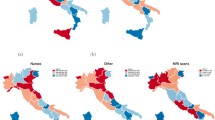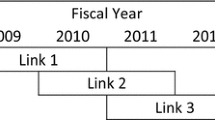Abstract
In this paper, we examine efficiency and total factor productivity for hospitals operating in China between the years of 2009–2016. Given reforms in China focusing on the hospital sector, it has been demonstrated that efficiency and productivity are important in meeting the overall objective of meeting more accessibility to hospital care for the population. Measuring an aggregate directional distance function is in itself a non-parametric approach, we report on the decomposition of hospital performance and found that between 2009 and 2010, technical inefficiency (using resources inefficiently) dominated overall inefficiency but beyond 2011–2016, mix inefficiency (misallocation of resources) was higher. Furthermore, an additive total factor productivity (TFP) indicator is proposed to capture contributions of individual provincial (or group) hospital performance to the total productivity gain. We also report that mix inefficiency had growth throughout this time period indicating a catching up in the correct mix of inputs. This finding is worth following as hospital reform in China also focuses on utilizing the right labor and capital mix in producing efficient care.

Similar content being viewed by others
Notes
As a reminder, the Malmquist approach uses inputs and outputs from multiple time periods comparing what could be produced using year 1’s inputs and compares this to year 2’s output. The index is analogous to traditional indices such as Paasche and Laspeyre, but instead of using prices and commodities of goods purchased, the Malmqusit approach uses inputs and outputs. For a further review, see (Färe, et al.s [16]).
We ignore the regions of Hong Kong, Macao and Taiwan in China due to data accessibility.
References
Hu H, Qi Q, Yang C (2012) Analysis of hospital technical efficiency: effect of health insurance reform. China Econ Rev 23(4):865–877
Blumenthal D, Hsiao W (2005) Privatization and its discontents – the evolving Chinese health care system. N Engl J Med 353(11):1165–1170
Barber S, Borowitz M, Bekedam H, Ma J (2014) The hospital of the future in China: China’s reform of public hospitals and trends from industrialized countries. Health Policy Plan 29(3):367–378
Liu G, Vortherms S, Hong X (2017) China’s health reform update. Annu Rev Public Health 38:431–448
Zhang Y, Ma Q, Chen Y, Goa H (2017) Effects of public hospital reform on inpatient expenditures in rural China. Health Econ 26(4):421–430
Liu X, Liu Y, Chen N (2000) The Chinese experience of hospital price regulation. Health Policy Plan 15(2):157–163
Gerdtham U, Sogaard J, Andersson G, Jonsson B (1992) An econometric analysis of health care expenditure: a cross-section study of the OECD countries. J Health Econ 11(1):63–84
Audibert M, Mathonnat J, Pelissier A, Huang H, Ma A (2013) Health insurance reform and efficiency of township hospitals in rural China: an analysis from survey data. China Econ Rev 27:326–338
China sets up new system to optimize medical resources. National Health Commission of the Peoples Republic of China (2015) http://en.nhc.gov.cn/2015-09/16/c_46816.htm
Yip W, Hsiao W (2008) The Chinese health system at a crossroads. Health Aff 27(2):460–468
Daemmich A (2013) The pollical economy of healthcare reform in China: negotiating public and private. Springer Plus 2:448–463
Li H, Dong S, Liu T (2014) Relative efficiency and productivity: a preliminary exploration of public hospitals in Beijing, China. BMJ Health Services Research 14:158–168
Ng. Y (2011) The productive efficiency of Chinese hospitals. China Econ Rev 22:428–439
Hu H, Qi Q, Yang C (2012) Evaluation of China’s regional hospital efficiency: DEA approach with undesirable output. J Oper Res Soc 63(6):715–725
Wang M, Fang H, Tao H, Cheng Z (2017) Bootstrapping data envelopment analysis of efficiency, and productivity of county hospitals in eastern, central, and Western China after public hospital reform. J Huazhong University Sci Technol 37(5):681–692
Färe R, Grosskopf S, Lindgren B, Roos P (1992) Productivity changes in Swedish pharmacies 1980-1989: a non-parametric Malmquist approach. J Prod Anal 3(1–2):85–101
Cheng Z, Tao H, Lin H, Lin X, Zhang R (2015) Technical efficiency and productivity of Chinese county hospitals: an exploratory study in Henan Province. BMJ Open Access 5:e007267. https://doi.org/10.1136/BMJOpen-2014-007267
Chu K, Zhang N, Chen Z (2015) The efficiency and its determinants for China’s medical care system: some policy implications for Northeast China. Sustainability 7(10):14092–14111
Yang, J., Zeng W. (2014). The tradeoff between efficiency and quality in the hospital production: some evidence from Shenzhen, China. China Econ Rev 31 166–184
Boussemart, J-P., Ferrier, G., Leleu, H., Shen, Z. (2018) An expanded decomposition of the Luenberger productivity indicator with an application to the Chinese healthcare sector. IESEG working paper
Hackman ST (2008) Production economics: integrating the microeconomic and engineering perspectives. Springer, Berlin
Li SK (1995) Relations between convexity and homogeneity in multi-output technologies. J Math Econ 24:311–318
Ferrier G, Leleu H, Valdmanis V (2010) The impact of CON regulation on hospital efficiency. Health Care Management Sci 83(1):84–100
Chambers R, Chung Y, Färe R (1996) Benefit and distance functions. J Econ Theory 70(2):407–419
Boussemart JP, Leleu H, Shen Z (2015) Environmental growth convergence among Chinese regions. China Econ Rev 34:1–18
Briec W, Kerstens K (2004) A Luenberger-Hicks-Moorsteen productivity indicator: its relation to the Hicks-Moorsteen productivity index and the Luenberger productivity indicator. Economic Theory 23:925–939
Kerstens K, Shen Z, Van de Woestyne I (2018) Comparing Luenberger and Luenberger-Hicks-Moorsteen productivity indicators: how well is total factor productivity approximated? Int J Prod Econ 195:311–318
National Bureau of Statistics of China (2017) http://www.stats.gov.cn/english/Statisticaldata/AnnualData/
Ma J, Lu M, Quan H (2008) From a national, centrally planned health system to a systems based on the market: lessons from China. Health Aff 27(4):937–948
Shi J, Liu M, Zhang Q, Lu M, Quan H (2008) Male and female adult population health status in China: a cross-sectional national survey. BMC Public Health 8:277–286
Gong P, Liang S, Carlton E, Jiang Q, Wu J, Wang L, Remais J (2012) Urbanisation and health in China. Lancet 379:843–851
Yu H (2015) Universal health insurance coverage for 1.3 billion people: what accounts for China’s success? Health Policy 119:1145–1152
Funding
There was no external funding received for this study.
Author information
Authors and Affiliations
Corresponding author
Ethics declarations
Conflict of interest
There is no conflict of interest between the authors and other agencies or persons.
Ethical approval
This article does not contain any studies with human participants or animals performed.
Additional information
Publisher’s note
Springer Nature remains neutral with regard to jurisdictional claims in published maps and institutional affiliations.
Rights and permissions
About this article
Cite this article
Shen, Z., Valdmanis, V. Identifying the contribution to hospital performance among Chinese regions by an aggregate directional distance function. Health Care Manag Sci 23, 142–152 (2020). https://doi.org/10.1007/s10729-019-09482-4
Received:
Accepted:
Published:
Issue Date:
DOI: https://doi.org/10.1007/s10729-019-09482-4
Keywords
- China hospitals
- Aggregate directional distance function
- Additive Total factor productivity
- China hospital productivity




